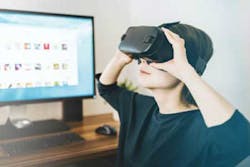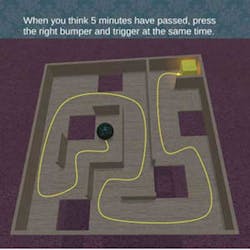Virtual reality (VR) technology has a way of messing with our senses.
The immersive effect—when our experience in the virtual environment is similar to our experience in the real world—is effective when the brain interprets sensory information to make sense of what’s happening in the virtual environment. This understanding is called our perception.
In a virtual world, the brain functions efficiently by applying past experience to make sense of virtual objects. VR developers use laws of physics to help trick the brain into applying those rules in a virtual setting.
Perception, for example, has been a prominent topic in VR research for decades. The sky can denote direction, shading can provide depth and the relative size of objects can suggest distance. Where VR environments have diminished perceptions of size and distance, researchers have shown that these deficits can be reduced or compensated for by enhancing presence in the form of the self-perspective of an avatar. (Presence is a measure of how much a person feels they are in the VR environment.)
One factor that has received less attention is time. In a recent experiment, researchers designed an experiment to figure out why users lose track of time—or perception of how much time has lapsed—while playing video games.
Results of the experiment, conducted by Grayson Mullen, a cognitive science student at UC Santa Cruz, with support from Psychology Professor Nicolas Davidenko, have been published in the journal Timing & Time Perception.
Setting out to learn how the effects of using a VR headset while playing a game versus using a conventional monitor differ, Mullen designed a maze game for both formats. The research team recruited 41 UC Santa Cruz students to test the game. While researchers randomized which version of the game each student started with, all participants played both games. Both versions were essentially the same, noted the researchers, but the mazes in each varied slightly so that there was no repetition between formats.
Participants were instructed to stop playing the moment they felt five minutes had passed. Each student had to estimate this based on their own perception of the passage of time.
In this experiment the research team integrated the time-keeping task into the virtual reality experience and allowed them to capture what was happening in the moment. Researchers recorded the actual amount of time that had passed when each participant stopped playing the game, and this revealed a gap between participants’ perception of time and the reality.
The researchers hypothesized that if VR interferes with normal time perception, participants may be less confident in their ability to track the passage of time.
The study found that participants who played the VR version of the game first played for an average of 72.6 sec. longer before feeling that five minutes had passed than students who started on a conventional monitor. That means that students played for 28.5% more time than they realized in VR, compared to conventional formats.
This effect, where time goes by faster than you think, is called “time compression” and was observed only among participants who played the VR game first.
The researchers concluded that if the time compression effects observed in the first round are translatable to other types of VR experiences and longer time intervals, it could help further inquiry into how the effect works.
Adverse effects of time compression or the inability to notice the passage of time may include inadvertently spending excessive amounts of time in games, as well as interference with players’ sleep schedules, mood and health, noted the paper.
On the flip side, there are situations in which the time compression might be beneficial. The researchers noted that VR could be used, for example, to reduce the duration of long-distance travel, or to reduce the negative psychological impact of painful medical treatments.
The researchers said future experiments could provide new insights to help designers
About the Author

Rehana Begg
Editor-in-Chief, Machine Design
As Machine Design’s content lead, Rehana Begg is tasked with elevating the voice of the design and multi-disciplinary engineer in the face of digital transformation and engineering innovation. Begg has more than 24 years of editorial experience and has spent the past decade in the trenches of industrial manufacturing, focusing on new technologies, manufacturing innovation and business. Her B2B career has taken her from corporate boardrooms to plant floors and underground mining stopes, covering everything from automation & IIoT, robotics, mechanical design and additive manufacturing to plant operations, maintenance, reliability and continuous improvement. Begg holds an MBA, a Master of Journalism degree, and a BA (Hons.) in Political Science. She is committed to lifelong learning and feeds her passion for innovation in publishing, transparent science and clear communication by attending relevant conferences and seminars/workshops.
Follow Rehana Begg via the following social media handles:
X: @rehanabegg
LinkedIn: @rehanabegg and @MachineDesign


